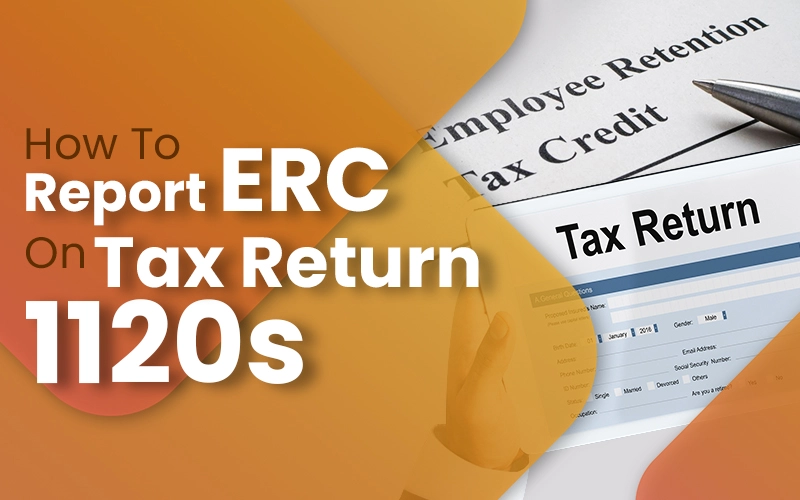
Are you a small business owner asking how to report ERC credit on tax return Form 1120S? You’re not alone. The Employee Retention Credit (ERC) was a major relief during the COVID-19 pandemic, but now many business owners are struggling to figure out how to properly report it for tax purposes.
In this comprehensive guide, we’ll walk you through everything you need to know about how to report ERC on tax return 1120S — from understanding what the ERC is, determining eligibility, and calculating your credit, to correctly reporting it on IRS forms like 941, Schedule K-1, and 1120S.
Let’s make sure you’re compliant, accurate, and maximizing your credit.
What Is ERC? (Employee Retention Credit Explained)
Before we dive into the nitty-gritty of reporting ERC on your tax return 1120S, let’s make sure we’re all on the same page about what ERC is.
The Employee Retention Credit is a refundable tax credit introduced to help businesses retain employees during the COVID-19 pandemic. It’s designed to provide financial relief to eligible employers who experienced economic hardship due to the pandemic.
Eligibility Criteria
Not every business qualifies. Here’s what you need to meet in order to claim the credit:
- Significant decline in gross receipts compared to 2019.
- Full or partial suspension of operations due to government COVID-19 orders.
- Fewer than 500 full-time employees (with certain exceptions for 2021).
Wondering whether you’re eligible and should you claim ERC with Wonder trust or another service? While many third-party providers offer filing help, you should always verify your eligibility with a trusted tax advisor or CPA to avoid potential issues.
How to Calculate the ERC
ERC amounts vary depending on the tax year:
- For 2020: 50% of qualified wages (up to $10,000 per employee annually).
- For 2021: 70% of qualified wages (up to $10,000 per employee per quarter).
Each quarter must be calculated separately to determine your full annual credit. This becomes essential when determining how to report ERC credit on your tax return correctly.
Choose the Right CPA Firm for Your Business
Partner with Jarrar & Associates for expert tax, accounting, and financial guidance tailored to your needs—so you can focus on growth.
How to Report ERC on Tax Return 1120S (Step-by-Step)
Now for the most important part — how to report employee retention credit on tax return Form 1120S. Here’s a simple breakdown:
1. Start with Form 941
You must first claim the ERC on Form 941, the Employer’s Quarterly Federal Tax Return. For each quarter in which you’re eligible, report the ERC on Line 11c (or Line 13d for prior period corrections). This step is crucial — your 1120S must align with what’s been reported here.
2. Report on Schedule K-1 (Form 1120S)
After claiming the ERC on Form 941, the next step is where to report employee retention credit on 1120S. The answer: Schedule K-1.
ERC is not treated as taxable income at the entity level but must be reported on the shareholder’s K-1 as part of other tax-exempt income. This ensures the credit flows through to individual shareholders correctly.
3. Adjust Income on Form 1120S
On Form 1120S, reduce your wage expense deductions by the amount of ERC claimed. This avoids double-dipping — you cannot deduct wages that were offset by the credit.
This is the key step for those wondering how to report ERC credit on tax return and where to report ERC refund on 1120S — the credit reduces deductible wages, and the refund isn’t separately reported as income.
Why Accurate ERC Reporting Matters
Many business owners are asking how do I report ERC credit on my tax return after receiving IRS letters or facing delays. Misreporting the ERC can trigger audits, delays in refunds, or even penalties.
If you’re using a third-party service like Wonder trust, always confirm that their filings are accurate. When in doubt, consult a tax professional.
Wrapping It Up
In summary, reporting ERC on your tax return 1120S may seem daunting at first, but with a little bit of guidance, it’s entirely manageable. By following the steps outlined in this blog post, you can ensure that you’re accurately reporting the credit and maximizing your tax savings.
Quick Note: Remember, understanding how to report ERC on tax return 1120S is crucial for maximizing your tax savings and ensuring compliance with IRS regulations. By following these steps, you can navigate the process with confidence and ease.
So there you have it. Our comprehensive guide on how to report ERC on tax return 1120S. We hope you found this information helpful, and if you have any further questions, don’t hesitate to contact a tax professional for assistance. Happy reporting!
Also Read: Maximize Your Tax Refund in 2024



